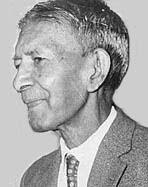Early life
Chelvanayakam was born in Ipoh, Malaysia, but returned to Sri Lanka (then called Ceylon) at the age of four. He studied at Union College, Tellippalai, and St. Thomas' College. At age 19, he had a bachelor's degree, and by 25, was called to the bar. He married Emily Grace Barr Kumuarakulasinghe two years later.
Political career
Chelvanayakam became active in the All Ceylon Tamil Congress during the drive for independence, becoming the party's deputy leader. He was elected to Parliament in the 1947 elections.
The ACTC was torn between Chelvanayakam and G.G. Ponnambalam, who pushed for greater cooperation with the United National Party government. Chelvanayakam broke with Ponnambalam in protest over the latter's support for the denial of citizenship to the estate Tamils in 1949. He went on to found a new, more aggressive party, the Federal Party. 

In the 1956 election, the Federal Party emerged as the leading party in the Tamil regions, but the new prime minister, Solomon Bandaranaike, pushed through the Sinhala Only Act, which met with stiff opposition from the Tamils.
Chelvanayakam led a satyagraha protest against the new law. The campaign succeeded at first in swaying the government, which negotiated the Bandaranaike-Chelvanayakam Pact which agreed to provide government services in Tamil and devolve powers to a set of provincial councils. Bandaranaike abandoned the pact after stiff opposition from Buddhist monks.
After his fruitless experience dealing with the Sri Lanka Freedom Party governments of 1956-65, Chelvanayakam turned to the UNP. After that party's victory in the 1965 election, the Federal Party joined the government of Dudly Senanayake. He signed the Senanayake-Chelvanayakam Pact which also provided for Tamil services and district councils.
Senanayake's regime failed to implement the Pact and as a result, Chelvanayakam and the FP left the government in 1968.
By the 1970s, Chelvanayakam had grown bitter over his failure to win any meaningful concessions from the Sinhalese, and became sympathetic to the cause of Tamil separatism. The FP and other parties merged into the Tamil United Liberation Front towards that end, with Chelvanayakam as their leader.
Death
His health was increasingly poor; he had suffered from Parkinson's disease and growing deafness since the 1950s. In 1961, Chelva underwent surgery in Edinburgh to relieve the stress from Parkinson disease at the hands of a neurosurgeon, Francis John Gillingham and the operation "proved successful." Despite the success of this operation, he died in 1977 at his home and was buried in Jaffna.
Profile
Member of the Sri Lanka Parliamentfor Kankesanthurai
In office1947–1952
Succeeded by Subaiya Nadesan, UNP

No comments:
Post a Comment